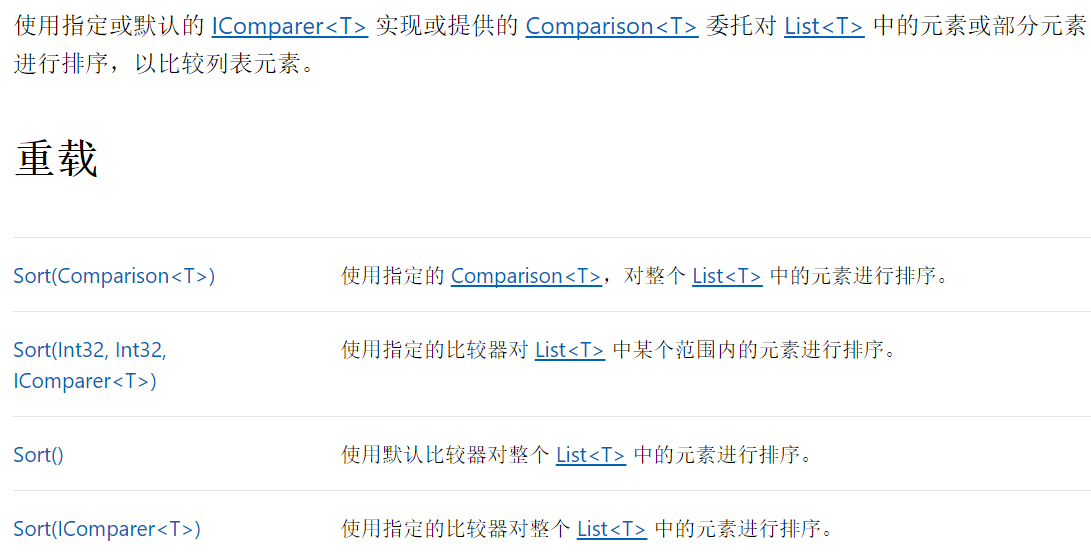1为什么要用集合
数组的局限性:数组元素个数固定,数组一旦定位就无法改变元素总数,如果有需求变化,则必须修改源码; 如果初始化元素总数非常大,则会造成空间浪费。
集合的特点:根据需要动态增加个数,没有限制。
2泛型集合List<T>
<T>表示泛型,T是Type的简写,表示当前不确定具体类型。
可以根据用户的实际需要,确定当前集合需要存放的数据类型,一旦确定不可改变。
使用泛型集合只能添加一种类型的数据,数据取出后无需强制转换。
使用前引入命名空间:System.Collections.Generic
常用方法:添加元素Add(<T>),删除元素Remove(索引) 元素个数:Count 使用可以用遍历foreach
泛型集合的最大特性:严格约束集合内的元素类型
3泛型集合Dictionary<K,V>
Dictionary<K,V>通常称为字典,<K,V>约束集合中元素类型。
编译时检查类型约束,无需拆装箱操作,与哈希表操作类似。
4List<T>默认排序
list.Sort(); 基本数据类型可以直接排序,对于字符串默认按照拼音首字母升序排列
调用集合中的Reverse()方法,实现元素反转。
如果T不是基本数据类型而又想对其排序,T这个类必须继承IComparable<T>这个接口,并且必须对提供泛型接口要实现的方法,这个方法一般直接显示接口,但当此类继承自多个接口时需要显式实现接口。此实现接口方法的签名和返回值类型以及方法名不可更改。

1 public int CompareTo(Student other) 2 { 3 //return other.stuName.CompareTo(this.stuName); //other在前,降序 4 5 return this.StuId.CompareTo(other.StuId); //this在前,升序 6 }
默认的排序方式,只能有一种。

5List<T>动态排序
如果仅对姓名进行升序或学号进行降序等可只用List<T>默认排序。List<T>只有一种排序方式。
但在实际项目中,可能有时是姓名升序、有时是姓名降序、有时是学号升序、有时是学号降序,需要用到ICompare<T>接口。使用比较器ICompare<T>实现动态排序。
默认排序可完全被比较器IComPare<T>所替代。

1 //年龄升序排列 2 class AgeASC : IComparer<Student> 3 { 4 public int Compare(Student x, Student y) 5 { 6 return x.Age - y.Age; 7 } 8 } 9 //年龄降序排列 10 class AgeDESC : IComparer<Student> 11 { 12 public int Compare(Student x, Student y) 13 { 14 //return y.Age - x.Age; 15 return y.Age.CompareTo(x.Age); 16 } 17 } 18 //姓名升序排列 19 class NameASC : IComparer<Student> 20 { 21 public int Compare(Student x, Student y) 22 { 23 return x.StuName.CompareTo(y.StuName); //x在前,升序 24 } 25 } 26 //姓名降序排列 27 class NameDESC : IComparer<Student> 28 { 29 public int Compare(Student x, Student y) 30 { 31 return y.StuName.CompareTo(x.StuName); //y在前,降序 32 } 33 }
6总结Sort()方法
6.1List集合的Sort方法共有4种。
Sort():使用默认比较器IComparable<T>排序对象。
Sort(ICompare<T> compare):将实现比较器接口的对象作为参数,这个对象是指继承了此比较器接口的类的对象。
6.2集合排序总结
如果是基本数据类型元素,可以直接排序。
如果是对象类型元素:
1.当排序只有一种的时候,可以使用默认比较器IComparable<T>在类中直接实现接口即可。
2.当需要多种排序的时候,需要添加对应排序类,并给每一个排序类实现比较器接口ICompare<T>来完成不同排序方法。
7使用Linq排序

1 static void Main(string[] args) 2 { 3 //实例化List<T>集合对象 4 List<Student> list = new List<Student>(); 5 //添加对象元素 6 Student objStu1 = new Student() { Age = 20, StuId = 1001, StuName = "小张" }; 7 Student objStu2 = new Student() { Age = 25, StuId = 1003, StuName = "小李" }; 8 Student objStu3 = new Student() { Age = 22, StuId = 1002, StuName = "小王" }; 9 list.Add(objStu1); 10 list.Add(objStu2); 11 list.Add(objStu3); 12 //默认排序 13 Console.WriteLine("------------默认排序------------"); 14 for (int i = 0; i < list.Count; i++) 15 { 16 Console.WriteLine("姓名:{0} 年龄:{1} 学号:{2}", list[i].StuName, list[i].Age, list[i].StuId); 17 } 18 //年龄降序排序 19 Console.WriteLine("------------年龄降序排序------------"); 20 List<Student> stuList = list.OrderByDescending(s => s.Age).ToList(); 21 for (int i = 0; i < stuList.Count; i++) 22 { 23 Console.WriteLine("姓名:{0} 年龄:{1} 学号:{2}", stuList[i].StuName, stuList[i].Age, stuList[i].StuId); 24 } 25 //姓名升序排序 26 Console.WriteLine("------------姓名升序排序------------"); 27 stuList = list.OrderBy(s => s.StuName).ToList(); 28 for (int i = 0; i < list.Count; i++) 29 { 30 Console.WriteLine("姓名:{0} 年龄:{1} 学号:{2}", stuList[i].StuName, stuList[i].Age, stuList[i].StuId); 31 } 32 Console.ReadLine(); 33 } 34 #endregion
8.泛型
8.1可以使用泛型方法、泛型类、泛型接口、泛型委托。泛型类可以被继承,但继承的时候必须指定参数类型;可以在子类中指明参数类型,也可以只在泛型类指明参数类型;泛型接口 继承和泛型类继承是一样的。
8.2泛型约束:可以是基类约束、接口约束、引用类型约束(T:class)、值类型约束(T:struct)、无参数构造函数约束(T:new())
默认值——>>值类型示例 T t = default(T) ; //前提是值类型,这个default会根据T的不同,赋予默认值
默认值——>>无参数构造函数约束示例 T t = new T ();
泛型使用的方法是参数类型未事先指明,任何类型都可以进来,这样做是不安全的。所以这时需要使用到泛型约束。约束可以是基类约束,例如Where T:People,就指明这里的T必须是People,不能Dog/Cat之类的。赋予了T:People,强制保证T一定是People或者People的子类,就可以使用基类的一切属性和方法。
约束可以叠加,Where T : People,ISports //表明既可以继承People类,又可以继承ISports接口
8.3协变和逆变

public class Bird { public int Id { get; set; } } public class Sparrow : Bird { public string Name { get; set; } }

Bird bird1 = new Bird(); //声明一只鸟,就是一只鸟,OK Bird bird2 = new Sparrow(); //声明一只鸟,指明它是麻雀,OK Sparrow sparrow1 = new Sparrow(); //声明一只麻雀,就是一只麻雀,OK //Sparrow sparrow2 = new Bird(); //声明一个麻雀,指明它是一只鸟,不OK,因为并不是所有的鸟都是麻雀,也有可能是鹦鹉

List<Bird> birdList1 = new List<Bird>(); //OK,声明一群鸟,指明它们就是一群鸟 //List<Bird> birdList2 = new List<Sparrow>(); //不OK //声明一群鸟,指明它们就是一群麻雀,道理上行得通,因为一堆麻雀当然是一堆鸟。但C#两个集合对象之间没有父子关系 //Bird bird2 = new Sparrow();是OK的,因为Bird与Sparrow之间存在父子关系 List<Bird> birdList3 = new List<Sparrow>().Select(c => (Bird)c).ToList();

IEnumerable<Bird> birdList1 = new List<Bird>(); IEnumerable<Bird> birdList2 = new List<Sparrow>(); Func<Bird> func = new Func<Sparrow>(() => null);

ICustomerListIn<Bird> birdList1 = new CustomerListIn<Bird>(); birdList1.Show(new Sparrow()); birdList1.Show(new Bird()); Action<Sparrow> act = new Action<Bird>((Bird i) => { });
